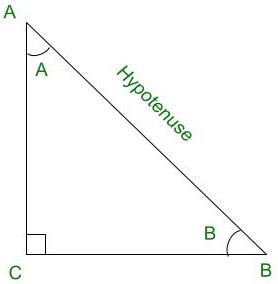Find the value of sin 31π/3
Last Updated :
21 Sep, 2021
Trigonometry is the relation between the angles and sides of a right-angled triangle. In a right angles triangle, there are 3 angles of which one angle is a right angle (90°) and the other two angles are acute angles and there are 3 sides. The side opposite to the right angle is called Hypotenuse. There are 6 ratios between these sides based on the angle between them and they are called Trigonometric Ratios.
The 6 Trigonometric ratios are:
- Sine (sin)
- Cosine (cos)
- Tangent (tan)
- Cosecant (cosec)
- Secant (sec)
- Cotangent (cot)

Right-angled triangle ACB
Sine (sin):
Sine of an angle is defined by the ratio of lengths of sides which is opposite to the angle and the hypotenuse. For the above triangle, the value of angle sine is given for both ∠A and ∠B, the definition for sine angle is the ratio of the perpendicular to its hypotenuse.


Cosine (cos):
Cosine of an angle is defined by the ratio of lengths of sides which is adjacent to the angle and the hypotenuse. For the above triangle, the value of the angle cos is given for both ∠A and ∠B, the definition for cos angle is the ratio of the base to its hypotenuse.


Tangent (tan):
The tangent of an angle is defined by the ratio of the length of sides which is opposite to the angle and the side which is adjacent to the angle. For the above triangle, the value of the angle tan is given for both ∠A and ∠B, the definition for tan angle is the ratio of the perpendicular to its base.


Cosecant (cosec):
The cosecant of an angle is defined by the ratio of the length of the hypotenuse and the side opposite the angle. For the above triangle, the value of the angle cosec is given for both ∠A and ∠B, the definition for cosec angle is the ratio of the hypotenuse to its perpendicular.


Secant (sec):
Secant of an angle is defined by the ratio of the length of the hypotenuse and the side and the side adjacent to the angle. For the above triangle, the value of the angle sec is given for both ∠A and ∠B, the definition for sec angle is the ratio of the hypotenuse to its base.


Cotangent (cot):
The cotangent of an angle is defined by the ratio of the length of sides that is adjacent to the angle and the side which is opposite to the angle. For the above triangle, the value of the angle cot is given for both ∠A and ∠B, the definition for cot angle is the ratio of the hypotenuse to its base.


Find the value of sin 31π/3
Solution:
sin = sin(10
= sin(10 +
+ )
)
⇒ sin = sin (5x(2
= sin (5x(2 ) +
) + )
)
We know that, the values of sine (sin) repeat after the interval of 2 .
.
⇒ sin = sin (
= sin ( )
)
⇒ sin = √3/2 ………(Since, sin (
= √3/2 ………(Since, sin ( )= √3/2)
)= √3/2)
Therefore, the value of sin is √3/2.
is √3/2.
Similar Problems
Question 1: Find the value of tan ( ).
).
Solution:
tan = tan (5x(2
= tan (5x(2 ) +
) + )
)
We know that, the values of tangent (tan) repeat after the interval of 2 .
.
⇒ tan = tan (
= tan ( )
)
⇒ tan = √3 ………(Since, tan (
= √3 ………(Since, tan ( ) = √3)
) = √3)
Therefore, the value of tan is √3.
is √3.
Question 2: Find the value of cos ( )
)
Solution:
cos = cos(4
= cos(4 +
+ )
)
⇒ cos = cos (2x(2
= cos (2x(2 ) +
) + )
)
We know that, the values of cosine (cos) repeat after the interval of 2 .
.
⇒ cos = cos (
= cos ( )
)
⇒ cos = 0 ………(Since, cos (
= 0 ………(Since, cos ( ) = 0)
) = 0)
Therefore, the value of cos is 0.
is 0.
Question 3: Find the value of cosec (– ).
).
Solution:
cosec(– ) = – cosec(
) = – cosec( ) ………(Since, – cosec (– θ) = – cosec (θ))
) ………(Since, – cosec (– θ) = – cosec (θ))
⇒ cosec (– ) = – cosec(10
) = – cosec(10 +
+ )
)
⇒ cosec (– ) = – cosec (5x(2
) = – cosec (5x(2 ) +
) + )
)
We know that, the values of cosecant (cosec) repeat after the interval of 2 .
.
⇒ cosec (– ) = – cosec (
) = – cosec ( )
)
⇒ cosec (– ) = – √2 ………(Since, cosec (
) = – √2 ………(Since, cosec ( )= √2)
)= √2)
Therefore, the value of cosec (– )is (– √2).
)is (– √2).
Question 4: Find the value of sec ( ).
).
Solution:
sec = sec(2
= sec(2 +
+ )
)
⇒ sec = sec (2x(2
= sec (2x(2 ) +
) + )
)
We know that, the values of secant (sec) repeat after the interval of 2 .
.
⇒ sec = sec (
= sec ( )
)
⇒ sec = √2 ………(Since, sec (
= √2 ………(Since, sec ( ) = √2)
) = √2)
Therefore, the value of sec is √2 .
is √2 .
Like Article
Suggest improvement
Share your thoughts in the comments
Please Login to comment...